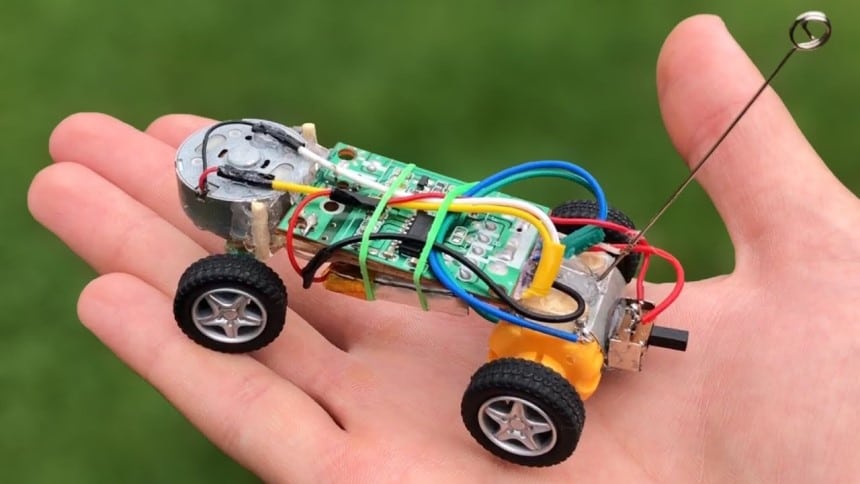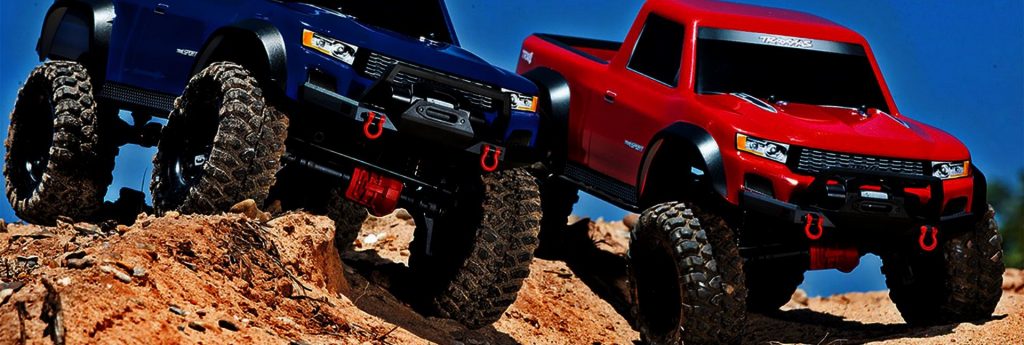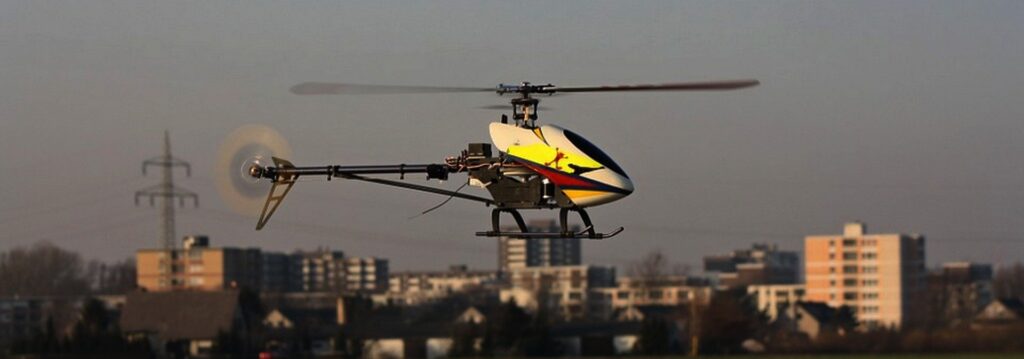RC stands for radio-controlled. They are also called remote-controlled cars. RC cars are composed of a chassis of an engine and radio control. How RC cars work is simple to understand but you have to be aware that there are electric and fuel-powered RC cars.
The operation of a radio-controlled car is different in a combustion model that uses gasoline than in an electric one that is powered by rechargeable batteries. Electric cars are powered by electricity, supported by more or less powerful batteries. Gasoline cars, on the other hand, are powered by fuel and an engine that works similarly to that of a real car.
Regardless of the model, these vehicles are controlled by a remote control that works by radiofrequency waves at different bands. These communicate with a receiver located in the car to synchronize the movements of the control with those of the tires and the different functions of the vehicle!
Below are the different parts and features that make up an RC car.
 Shell and lower chassis
Shell and lower chassisLike you can find in real cars, the lower chassis is the base frame of the radio-controlled car. Often made of metal, aluminum, and/or acrylic, this is where the wheels are connected. It is the frame of the car.
The shell and lower chassis are the main support structure of the car. These are where all other components are attached.
The chassis are even more visible and important in RC buggy cars. The strength, lightness, and general engineering will give good structure to the car, allow better drifting and balance in sharp corners.
According to most reviews, the sturdiest RC buggy car must be the Losi RC Truck, which, thanks to its reinforced construction and brushless, ready to run (RTR) engine, is the most reliable option out there.
There are two types of RC cars. They are categorized according to their power source. There are fuel-powered and electric or battery-powered RC cars.
They are very powerful and easy to use remote control vehicles because you only need to have the batteries charged and run! They also require no engine maintenance and make very little noise. The downside however is having to charge the batteries for longer than you can use the car.
For a first car, it is better to opt for an electric car. Today, their powers are largely equal to those equipped with a heat engine, and the complexity of adjustments and maintenance is reduced.
Still for the electric car, prefer a brushless motor to a brushed motor (old generation). The performance has improved considerably, the battery consumption is lower, the runtime and the battery life are also increased. An electric vehicle is of course quieter. It is true that smelling gasoline and hearing your thermal car backfiring provides more sensations, but the advantages of the electric car are still numerous, especially the price.
These radio-controlled cars with a fuel engine have much more runtime than an electric model and are very powerful. The noise that they make that imitates a real model is very attractive for fans of this hobby, although this may be annoying for the neighbors. The disadvantage however is that the engine requires maintenance and it is recommended to have knowledge of carburetion to use them properly.
All gasoline RC cars have two different systems: an electric system (which moves the steering, brakes, and intake system through servos) and a small two-stroke internal combustion engine.
However, the nitro engines Trusted Source Nitro engine - Wikipedia A nitro engine generally refers to an engine powered with a fuel that contains some portion (usually between 10% and 40%) of nitromethane mixed with methanol. en.wikipedia.org do not use the same fuel as real cars. They may use gasoline or nitro fuel. Some work with a specific mixture of methanol (80%), nitromethane (variable percentage, the more this is in the fuel, the more cool your engine is), castor oil (5%), and synthetic oil (5%).
The thermal engines are generally a 2-stroke engine running on methanol and delivering impressive power for their small-displacement (from 0.7 cm3 to 20 cm3). The starting is carried out either by means of an integrated pull starter or with an auxiliary electric starter.
The choice of engine is made on size (depending on scale) and category. Thus, the bigger the car, the bigger the engine will have to be. However, be careful not to choose a motor that is too big. For example, a 1/8 Truggy engine cannot be mounted on a 1/10 Truggy because there is too little space available on the frame.
There are two types of motors in RC cars:
According to most reviews, one of the most popular RC cars with a brushed motor is the Redcat Racing EPX Drift Car which has a 19T RC550 brushed motor and 2.4 GHz radio system
Tip: To imagine the power of the car, check the number of kV of the motor indicated in the datasheet. The kV indicates the number of revolutions/minute per volt of the motor, therefore its maximum claimed speed. In short, the higher the number of kV, the faster the car will be. However, be careful not to overlook one point: the higher the speed, the less torque the car has.
The transmitter transforms the commands given to the control sticks into signals and transmits them to the model. Each lever is mechanically connected to a potentiometer. When the lever is moved, the axis of the potentiometer is therefore rotated.
A potentiometer is an electrical circuit that transforms the position of the rod into an electrical signal: an electrical resistance. The potentiometer, therefore, gives the electrical measurement of the position of the lever to the electronic circuit of the remote control.
The receiver located in the car transforms the radio signals sent by the remote control into an electrical impulse which, in turn, is transmitted to the various control elements.
The circuit board of the RC car is a board through which all the commands are received and transmitted to all the control elements of the car.
A circuit board has the radio receiver, the amplifier, as well as the IC chip. It receives signals from the car’s transmitter and then activates the motors as commanded by the transmitter.
The servo or servo motor is a motor coupled to a reduction gear and a lifting beam, capable of maintaining an angular position, with a range of -45 ° to + 45 °. On remote-controlled cars, there is always at least one servo motor, for the steering. So when you turn the steering wheel, the servomotor will follow the movement, and the front wheels will turn at the same angle.
There are 2 families of servomotors: analog and digital. The difference lies in the internal electronics for command and control of the position. The control signal remains the same in both cases, and it is quite possible to use either one.
The controller (ESC) or variator is an essential element, connecting the motor to the battery, and controlling the motor according to the signal received by the radio receiver.
As its name suggests, this element controls the speed of the electric motor. Using an electronic variator eliminates the servo and mechanical variator. The centerpiece of your radio installation, it allows well-dosed linear accelerations and braking. Some also have a reverse function.
The characteristics to be taken into account are speed and torque and depend on the supply voltage and the use. With a brushless system, the servo is generally supplied with 6V by the speed controller, through the receiver. Finally, an important element, the internal gears must be made of metal.
The operation is different depending on the type of car:

The radio system is used to control the car. It contains an electronic circuit, the transmitter, which transforms the driver’s actions on the levers or the steering wheel of the remote control into radio signals sent to the car’s radio receiver.
When the antenna of the remote control is traversed by a current, it emits electromagnetic waves.
These waves propagate in space and are collected by the receiving antenna (like waves on the sea, but invisible). The electromagnetic waves generate in the receiving antenna an alternating current of the same frequency as that which traverses the transmitting antenna and thus leads to mechanical action.
The channels have two functions: to steer and throttle. Most RC cars use two channels: channel 1 is for steering and channel 2 is for throttling. With more than two channels, you’ll be able to control light and sound systems, make gun elevations, and have turret rotation.
RC vehicles have their vocabulary and technical aspects. There are a lot of very interesting parts on a radio-controlled car. On the car, there is the chassis, the body, the engine, the wheels, the control circuit, the receiver, the battery, and more. When you start, it is essential to know the main parts that make up your electric car or your thermal car and how RC cars work in general.
The cheapest electric cars will have a brushed motor. The faster and more expensive cars will have a brushless motor. The brushless motors cost more than the brushed motor but offer higher speeds, maintenance almost zero, and a much longer lifespan.
All-electric cars run on a battery so that they can be supplied with electricity. Depending on the models you choose, the battery may or may not be included. Two types of batteries are mainly used in RC: NiMH batteries (easy to maintain and durable), and Lipo batteries (efficient and powerful but more delicate to handle).





